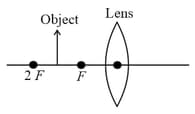Embibe Experts Solutions for Chapter: Ray Optics, Exercise 1: BITSAT 2017
Embibe Experts Physics Solutions for Exercise - Embibe Experts Solutions for Chapter: Ray Optics, Exercise 1: BITSAT 2017
Attempt the free practice questions on Chapter 16: Ray Optics, Exercise 1: BITSAT 2017 with hints and solutions to strengthen your understanding. EMBIBE CHAPTER WISE PREVIOUS YEAR PAPERS FOR PHYSICS solutions are prepared by Experienced Embibe Experts.
Questions from Embibe Experts Solutions for Chapter: Ray Optics, Exercise 1: BITSAT 2017 with Hints & Solutions
A convex lens of focal length produces images of the same magnification , when an object is kept at two positions and from the lens. The ratio of and is
In the shown situation, if middle portion of the lens is painted black, then

A convex lens shown in the figure is made up of two types of transparent materials. A point sources of light is placed on its principal axis. If reflections from the boundaries between layers are ignored, the lens will form

A planoconvex lens has thickness of When placed on a horizontal table, with the curved surface in contact with it, the apparent depth of the bottom most point of the lens is found to be If the lens is inverted such that the plane face is in contact with the table, the apparent depth of the centre of the plane face is found to be The focal length of the lens is (assume thickness of lens to be negligible)
The focal length of a thin convex lens for red and blue rays are and respectively. Then, the dispersive power of the material of the lens is
A plano-convex lens fits exactly into a plano-concave lens. Their plane surfaces are parallel to each other. If lenses are made of different materials of refractive indices and is the radius of curvature of the curved surface of the lenses, then the focal length of combination is
